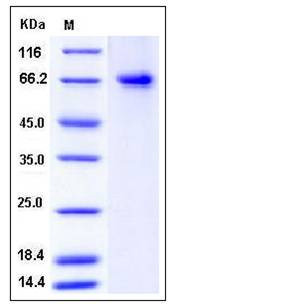Human PTGS2 / COX2 / PGHS-2 Protein (His Tag)
COX-2,COX2,GRIPGHS,hCox-2,PGG/HS,PGHS-2,PHS-2
- 100ug (NPP3767) Please inquiry
| Catalog Number | P12036-H08B |
|---|---|
| Organism Species | Human |
| Host | Baculovirus-Insect Cells |
| Synonyms | COX-2,COX2,GRIPGHS,hCox-2,PGG/HS,PGHS-2,PHS-2 |
| Molecular Weight | The recombinant human PTGS2 consists of 597 amino acids and predicts a molecular mass of 68.5 kDa. It migrates as an approximately 66 kDa band in SDS-PAGE under reducing conditions. |
| predicted N | Ala 18 |
| SDS-PAGE |  |
| Purity | > 95 % as determined by SDS-PAGE |
| Protein Construction | A DNA sequence encoding the human PTGS2 (NP_000954.1) (Met 1-Leu 604) was fused with a polyhistidine tag at the C-terminus. |
| Bio-activity | |
| Research Area | Developmental Biology |Metabolism |Pathways and Processes |Metabolism processes |Apoptosis |Oxidative Stress | |
| Formulation | Lyophilized from sterile 50mM Tris, 100mM NaCl, 0.5mM PMSF, 10% glycerol, pH 8.0 1. Normally 5 % - 8 % trehalose, mannitol and 0.01% Tween80 are added as protectants before lyophilization. Specific concentrations are included in the hardcopy of COA. |
| Background | PTGS2, also known as COX-2, is s component of Prostaglandin-endoperoxide synthase (PTGS). PTGS, also known as cyclooxygenase, is the key enzyme in prostaglandin biosynthesis, and acts both as a dioxygenase and as a peroxidase. There are two isozymes of PTGS: a constitutive PTGS1 and an inducible PTGS2, which differ in their regulation of expression and tissue distribution. PTGS2 is over expressed in many cancers. The overexpression of PTGS2 along with increased angiogenesis and GLUT-1 expression is significantly associated with gallbladder carcinomas. Furthermore the product of COX-2, PGH2 is converted by prostaglandin E2 synthase into PGE2, which in turn can stimulate cancer progression. Consequently inhibiting COX-2 may have benefit in the prevention and treatment of these types of cancer. PTGS2 is regulated by specific stimulatory events, suggesting that it is responsible for the prostanoid biosynthesis involved in inflammation and mitogenesis. It mediates the formation of prostaglandins from arachidonate and may have a role as a major mediator of inflammation and/or a role for prostanoid signaling in activity-dependent plasticity. |
| Reference |
